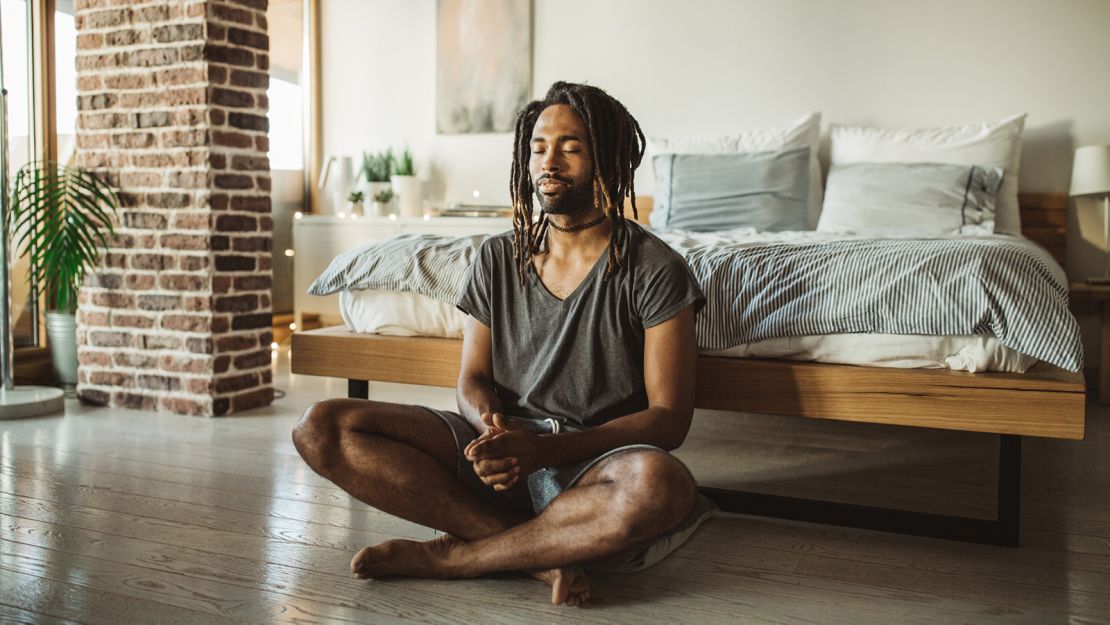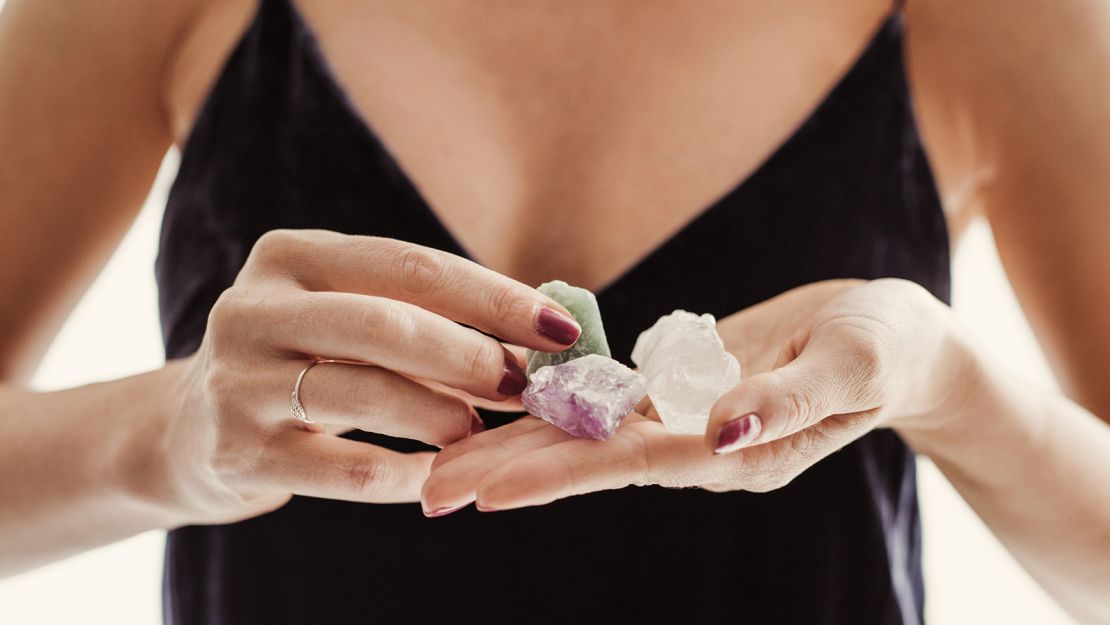For thousands of years, meditation has been used as a way to disconnect from the outside world and tune in to yourself, lower stress levels and find rest in the evening. And while this all sounds great and dandy, the biggest hurdle to a meditation practice is getting started.
The good news is that anyone — and yes, we mean anyone — can meditate. Like other rituals and skills in life, it takes preparation and practice and testing out a few methods to see which one resonates with your mental state the best.
Here, we spoke with meditation experts about creating a meditation ritual, reaping the benefits and of course, the essential products to invest in. Consider this your 101 guide to meditation.
What is meditation?
Meditation stems from the Latin word meditatus or mederi, meaning to remedy. Or if you want to take the official Merriam-Webster description, “To meditate is to spend time in quiet thought; to engage in contemplation or reflection or mental exercise for the purpose of reaching a heightened level of awareness.”
To put it simply, meditation is a time when you choose to be still in your own experience, to access expanded awareness and presence, according to Rachel Petri, a yoga and meditation teacher and the founder of Space to Breathe. “Meditation can be three breaths or 30 minutes. It can be absolute stillness, or focus on your breath, or presence to each movement you make,” she continues. “It is varied, but it is always the exercise of full presence to the moment, to be fully with yourself and the full spectrum of your experience.”
In other words, meditation is a time you give yourself to disconnect from everything around you and turn inwards to find your breath, a sense of calmness and hopefully, enlightenment.
What are the benefits of meditation?

Considering meditation is an ancient practice that’s utilized across the globe, it’s no surprise it comes with many benefits. Not only does a regular meditation ritual positively impact our minds, but it can help our bodies too. Here, a few of the most well-researched and documented benefits you can expect from tapping into meditation.
Increases self-awareness
Rather than thinking about the past or worrying about the future, meditation forces you to be fully in the present moment. “It not only shows us how to be more aware of our surroundings, but also of all the intricacies within ourselves,” says Kama Hagar, a holistic wellness and meditation coach. “Don’t be surprised if you find yourself noticing unconscious habits, patterns or unhelpful ways of thinking.”
Improves internal functions
On a physical level, meditation helps lower blood pressure and cholesterol; strengthens the immune system; enhances longer, better-quality sleep; promotes faster healing; increases blood flow and reduces pain, explains Lisette Cifaldi, a psychotherapist and former director of behavioral health for Hilton Head Health.
Provides stress release and promotes joy
Hagar explains when we meditate, we experience the opposite of fight-or-flight, the body’s stress response. “Instead, our breathing and heart rate slows, our stress hormones decrease in production, and even our platelets become less sticky, causing it to flow more easily throughout our entire body,” she says.
Plus, Cifaldi says meditation improves emotional awareness and reduces feelings of depression, anxiety, anger and confusion. “It’s also a practice that increases positive emotions such as serenity, peace and calm,” she adds.
Enhances creativity
Can’t seem to get through a workday without blankly staring at your computer screen? You don’t need a coffee break — you need a meditation break. Another benefit of meditation is that it enhances and inspires creativity while boosting productivity, says Linda Lauren, an avid meditator and a fifth-generation psychic medium. “It can help in problem-solving because it teaches us to not react to things, and that makes us better able to get along with ourselves and others,” she explains.
How to meditate properly

According to Martha Lockie, the co-creator of IntoMeSea and an avid meditator for over 40 years, it’s best to keep meditation as simple as possible in the beginning. The goal is to get comfortable settling into your body and mind to allow yourself to benefit from meditation. Here, Lockie provides an easy step-by-step guide.
- First, find a quiet place in the home. Turn off your phone (if you’re not using a guided meditation app) and ensure you won’t be disturbed by pets or other houseguests.
- Next, get comfortable. Lockie says the best position is in a chair with your back straight and your feet on the floor. This can be with a meditation pillow or chair.
- Then, gather everything you need for your meditation sanctuary. This could anything from crystals and blankets to a candle, a journal, etc. (More on this below!) These items create the ritual associated with establishing a meditation practice and everything that goes along with it.
- Now, begin breathing in a slow, deep fashion. With each exhale, feel your body sinking down with gravity. Put your attention at the back of your head, above your ears and well behind your eyes. Go back further than you think you should. Create a personal space here; make it your own.
- Next, place your attention at the bottom of your feet. As you breathe in, feel yourself pulling energy up from the center of the earth. Feel warm, slow earth energy traveling up your feet and legs to your hips on each inhale. Repeat this over and over. This is what is known as grounding, and is the foundation for any lasting meditation practice.
- Now, focus on a circle around your physical body. Lockie suggests imagining it two feet above, below, to the left and the right. See and feel it anchored and connected to the center of the Earth, however that looks to you. There is no right or wrong way.
- Return again to placing your attention in your meditation sanctuary. Focus again on the bottom of your feet, being grounded and on the exhale, reestablish the anchor you intuited dropping back into the center of the Earth.
- Breathe and repeat the process. Watch what comes up for you. Lockie says that trying to ‘empty the mind’ is a non-attainable feat and breeds frustration. Instead, stay in the back of the head, ground with the feet flat on the floor and continue to anchor and visualize.
What are the types of meditation?
There are countless types of meditation — from breathwork and visualization to walking meditation and many others. This is one of the most important things to remember about getting into the art of meditation: If one method doesn’t click for you, try another. Here, experts outline a few of the most widely practiced.
- Breathwork: In this, Cifaldi says we use the breath as an anchoring point by concentrating on its rhythm. As we become aware of the sound and sensation of the breath, as well as the rise and fall of our chest and belly, we move our awareness away from our thoughts.
- Guided meditation: In this method, you use your imagination to picture a scenario that a narrator describes. Cifaldi says an example would be picturing a walk on the beach that a narrator leads you through while asking you to imagine using your senses to along the walk.
- Vipassana meditation: This is the meditation that Buddha was practicing as he sat underneath the Bodhi Tree, Lockie says. In Vipassana, the meditator begins by placing their attention at the top of the head and moving it down the shoulders, arms, chest, torso, buttocks, legs and then out through the bottom of the feet.
- Transcendental meditation: Developed by Maharishi Mahesh Yogi in the 1960s, this is the practice of sitting comfortably with closed eyes and repeating a mantra given by a certified TM facilitator for 20 minutes twice a day.
- Walking meditation: Author and entrepreneur Adora Winquist says movement is critical to our overall health and well-being, making ‘walking meditation’ more popular. Walking in the woods or on the beach in silence and solitude is a time-honored meditation practice that can easily suit a busy schedule.
- Ho’oponopono meditation: License marriage and family therapist Amber Trueblood says this is a “clearing” meditation that many find deeply relaxing and rejuvenating. Sit in a quiet location with minimal distractions. Then, repeat the four short phrases, ‘I love you. I’m sorry. Please forgive me. Thank you.’ Relax your shoulders and repeat the phrases for ten cycles at the end of your day.
- Trataka meditation: This is a great technique for those who have a hard time closing their eyes while meditating and want to practice on their own, says Vibay Chandran, former managing technical program management for Mindbody. In this, you choose an object that makes you feel calm for their meditation practice. Then, sit down to meditate, grow aware of your breath and stare at the object without blinking your eyelids. Hold this state for as long as you can. Then, close your eyes, visualize the object, and think about its qualities while staying aware of your breath.
Does meditation work?
Those who swear by meditation will say, yes, it works. But those who dabble here and there may not truly realize the lasting impact on their psyche. That’s why if you want to get serious about meditation, you need to commit, says Susan Labunski, a holistic nutritionist and meditation teacher.
“Even if it’s for just one minute a day, it’s still considered meditation and will help clear your mind and relax,” she says. “Use an app with guided meditations. It is much easier to follow along with someone or something, rather than to try it alone, especially in the beginning or if you’re new to meditation.”
What is the best time to meditate?
While most practitioners will choose to meditate to start or end the day, truly, the best time to meditate is whatever time you can block out on your calendar that can assure you at least 10 to 20 minutes of privacy, Lauren says. Over time, you should integrate your daily meditation into your routine twice a day for the most benefit.
“Remind yourself that this is your time — ‘me’ time — and special to your mental health as it will relax you,” Lauren continues. “Twice a day, starting with 10 minutes and gradually going up to 20 minutes. Once in the morning to open your day and ground you. Once in the evening to unload yourself of the day’s trials and tribulations so that you can sleep well.”
What you may need to meditate

Crystals
Lauren’s top recommendation for outfitting your meditation sanctuary is to invest in quality crystals because they tap into our energy and feelings. “Crystals hold a vibration, and that vibration is what attunes us to our higher self and our deepest thoughts,” she says. Remember, each crystal has meaning, so choose wisely based on what you need the most help processing. This pack from Baloo Living includes an eye mask and your choice of one of four stones:
- Amethyst for calming, grounding, self-love and healing
- Purple fluorite for intuition, clarity, immunity and healing
- Blue lace agate for safety, security, balance and grounding
- Rose quartz for the release of stress, gentleness and purity
Credit: Source link